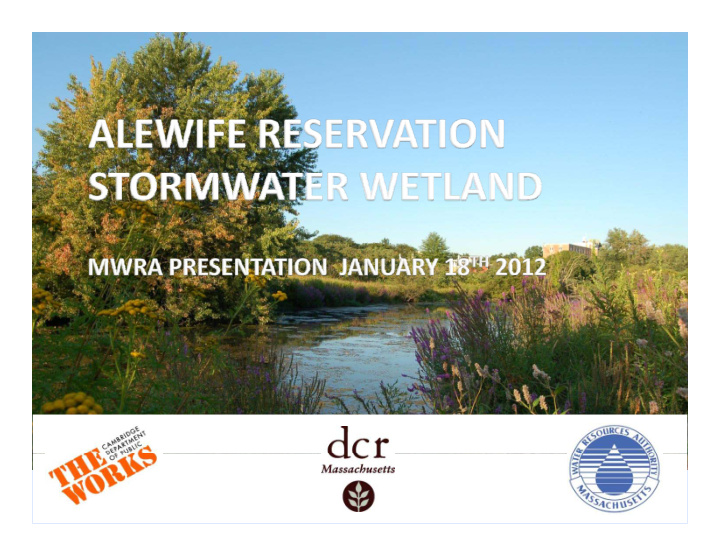



Erosion and sedimentation control Wildlife impacts Wildlife impacts Multi ‐ Use Path detour and signage g g
MWRA’s LTCP for CSO Control Sewer separation of CAM004 To be completed by December 2015. b l d b b 20 Closure of the CAM004 regulator Reduces volume and frequency of CSOs to the Alewife Brook ▪ 50mg annually 7 3mg ▪ 50mg annually 7.3mg ▪ 63 activations per year 7
BMP Devices (temporary) BMP Devices (temporary) Sediment control basins Flood protection berm Cover crop seed mix and/or matting Compost filter socks/silt fences Turbidity curtain Alewife Reservation
Stormwater Stormwater wetlands provide water quality t treatment through t t th h the interaction of the water, soil and , plants.
Sedimentation Adsorption to Sediments Physical filtration Volatilization NH 3 N 2 CO 2 , CH 4 Volatile organics Plant storage Microbial breakdown Plant Uptake Plant Uptake Decomposition Denitrification Organic C NO 3 ‐ Inflow Sedimentation Extra Detention and/or xtra etention and/or Plant uptake Burial Retention Adsorption ‐ NH 4 + , metals, P, organics (to clays, Fe / Al hydroxides, Soil storage organic matter) Precipitation (peat) ‐ P (with Fe, Al, Ca) ‐ Metals (with sulfides) Metals (with sulfides) Source: K.R. Reddy
Habitat Creation Deep, emergent and high marsh Wet meadow, broadleaf floodplain and open water Scrub/shrub and riparian woodland O Over 115,000 new wetland plants 115 000 tl d l t Over 3,800 new upland plants
DCR Reservation Features Multi ‐ use connector path (Mass DOT) Trails and boardwalks (1,600 linear feet) Overlooks (3) Amphitheatre p Benches and bike racks DCR Kiosk and interpretive signage
Forebay = 0.27 acres b (50ft x 170ft)
Stormwater Wetland Stormwater Wetland Footprint = 3.4 acres Primary Wetland = 2.8 ac. y Peninsula = 0.2 acres Habitat Diversity Habitat Diversity High Marsh Low Marsh Low Marsh Open Water Upland Island p
Erosion and sedimentation control Wildlife impacts Wildlife impacts Multi ‐ Use Path detour and signage g g
Wildlife Impact/Risk Assessment Conclusions: Wildlife Impact/Risk Assessment Conclusions: October start maximizes use of food resource Minimal breeding season/migratory bird risks Avoid Little River disturbance during Alewife run A id Littl Ri di t b d i Al if Licensed Wildlife Trappers were consulted: pp American Woodcock Predicted resident wildlife will leave work area when clearing and grubbing commence Relocate wildlife outside of Relocate wildlife outside of the work area
Preconstruction Wildlife Reconnaissance Preconstruction Wildlife Reconnaissance Search work area for burrows, dens, nest sites Provide “gaps” in construction fencing Site monitoring to detect any fauna at risk Preconstruction Rare Plant Reconnaissance Botanist searched entire impact area
Wetland Construction W tl d C t ti Pre Wetland Activities P W l d A i i i Utilities relocation Grubbing Species identification Species identification Earthwork: soil excavation E h k il i and berms Erosion control and impact mitigation Cover crop planting Cover crop planting Clearing – began October 1 Boardwalk and amphitheater construction Wetland soils, plantings and seeding Final path paving Fi l th i
Fall/Winter 2011 ‐ 2012 Spring 2012 Fall 2012/Spring 2013
Alewife Reservation
Observe plant growth Observe plant growth Replace vegetation as needed Identify invasive species for removal d if i i i f l E Exclusion Fencing l i F i
Alewife Reservation Project Benefits j Fully integrated with DCR Alewife Reservation and Greenway Master Plan: Water Quality Improvements: 3.4 acre treatment wetland, and future closure of the CAM004 regulator future closure of the CAM004 regulator Ecological enhancements of fish and wildlife habitat quality Mitigation of invasive plant species g p p Improved site amenities Educational and recreational opportunities
Cambridge in 1777
Recommend
More recommend